
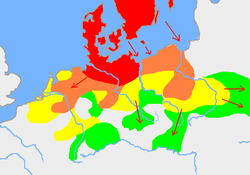
Iron Age Scandinavia (or Nordic Iron Age) was the Iron Age, as it unfolded in Scandinavia. It was preceded by the Nordic Bronze Age.


Iron Age Scandinavia (or Nordic Iron Age) was the Iron Age, as it unfolded in Scandinavia. It was preceded by the Nordic Bronze Age.
The 6th and 5th centuries BC were a tipping point for exports and imports on the European continent. The ever-increasing conflicts and wars between the central European Celtic tribes and the Mediterranean cultures destabilized old major trade routes and networks between Scandinavia and the Mediterranean, eventually breaking them down. Archaeology attests a rapid and deep change in the Scandinavian culture and way of life due to various reasons which have not yet been sufficiently analyzed. Agricultural production became more intensified, organized around larger settlements and with a much more labour-intensive production. Slaves were introduced and deployed, something uncommon in the Nordic Bronze Age. The rising power, wealth and organization of the central European tribes in the following centuries did not seem to instigate an increased trade and contact between Scandinavia and central Europe before 200‒100 BC. At this point the Celtic tribes had organized themselves in numerous urban communities known as oppida , and the more stable political situation in Europe allowed for a whole new economic development and trade. [2]
Bronze could not be produced in Scandinavia, as tin was not a local natural resource, but with new techniques, iron production from bog iron (mostly in Denmark) slowly gained ground. Iron is a versatile metal and was suitable for tools and weapons, but it was not until the Viking Age that iron incited a revolution in ploughing. [3] Previously, herds of livestock had pasture grazed freely in large wood pastures, but were now placed in stables, probably to utilize manure more efficiently and increase agricultural production. Even though the advent of the Iron Age in Scandinavia was a time of great crisis, the new agricultural expansions, techniques and organizations proceeded apace. And though the decline of foreign trade might suggest that the period marked a transition from a rich and wealthy culture to a poor and meagre one, the population grew and new technology was developed. The period might just reflect a change of culture and not necessarily a decline in standards of living. [2]
The Iron Age in Scandinavia and Northern Europe begins around 500 BC with the Jastorf culture, and is taken to last until c. 800 AD and the beginning Viking Age. It succeeds the Nordic Bronze Age with the introduction of ferrous metallurgy by contact with the Hallstatt D/La Tène cultures.
The Northern European Iron Age is the locus of Proto-Germanic culture, in its later stage differentiating into Proto-Norse (in Scandinavia), and West Germanic (Ingvaeonic, Irminonic, Istvaeonic) in northern Germany.
| Nordic Iron Age culture | |
|---|---|
| |
| |
| |
| Nordic Iron Age cult | |
|---|---|
| |
| |
| |

Scandinavia is a subregion in Northern Europe, with strong historical, cultural, and linguistic ties between its constituent peoples. Scandinavia most commonly refers to Denmark, Norway, and Sweden. It can sometimes also refer more narrowly to the Scandinavian Peninsula. In English usage, Scandinavia is sometimes used as a synonym for Nordic countries. Iceland and the Faroe Islands are sometimes included in Scandinavia for their ethnolinguistic relations with Sweden, Norway and Denmark. While Finland differs from other Nordic countries in this respect, some authors call it Scandinavian due to its economic and other similarities.
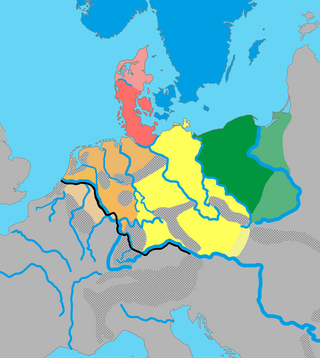
The East Germanic languages, also called the Oder-Vistula Germanic languages, are a group of extinct Germanic languages that were spoken by East Germanic peoples. East Germanic is one of the primary branches of Germanic languages, along with North Germanic and West Germanic.
The Danes were a North Germanic tribe inhabiting southern Scandinavia, including the area now comprising Denmark proper, northern and eastern England, and the Scanian provinces of modern-day southern Sweden, during the Nordic Iron Age and the Viking Age. They founded what became the Kingdom of Denmark. The name of their realm is believed to mean "Danish March", viz. "the march of the Danes", in Old Norse, referring to their southern border zone between the Eider and Schlei rivers, known as the Danevirke.

The Jastorf culture was an Iron Age material culture in what is now northern Germany and the southern Scandinavian Peninsula, spanning the 6th to 1st centuries BC, forming the southern part of the Pre-Roman Iron Age. The culture evolved out of the Nordic Bronze Age.

A rune is a letter in a set of related alphabets known as runic alphabets native to the Germanic peoples. Runes were used to write Germanic languages before they adopted the Latin alphabet, and for specialised purposes thereafter. In addition to representing a sound value, runes can be used to represent the concepts after which they are named (ideographs). Scholars refer to instances of the latter as Begriffsrunen. The Scandinavian variants are also known as futhark or fuþark ; the Anglo-Saxon variant is futhorc or fuþorc.
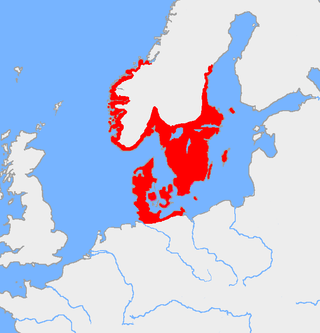
The Nordic Bronze Age is a period of Scandinavian prehistory from c. 2000/1750–500 BC.

In Swedish prehistory, the Vendel Period appears between the Migration Period and the Viking Age. The name is taken from the rich boat inhumation cemetery at Vendel parish church, Uppland. This is a period with very little precious metal and few runic inscriptions, crammed between periods with abundant precious metal and inscriptions. Instead, the Vendel Period is extremely rich in animal art on copper-alloy objects. It is also known for guldgubbar, tiny embossed gold foil images, and elaborate helmets with embossed decoration similar to the one found at Sutton Hoo in England.

The Scandinavian Peninsula became ice-free around the end of the last ice age. The Nordic Stone Age begins at that time, with the Upper Paleolithic Ahrensburg culture, giving way to the Mesolithic hunter-gatherers by the 7th millennium BC. The Neolithic stage is marked by the Funnelbeaker culture, followed by the Pitted Ware culture.
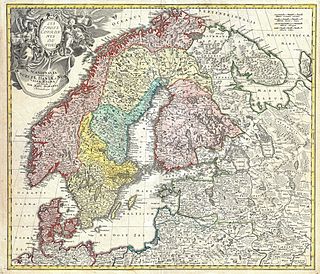
The history of Scandinavia is the history of the geographical region of Scandinavia and its peoples. The region is located in Northern Europe, and consists of Denmark, Norway and Sweden. Finland and Iceland are at times, especially in English-speaking contexts, considered part of Scandinavia.

The Nordic Stone Age refers to the Stone Age of Scandinavia. During the Weichselian glaciation, almost all of Scandinavia was buried beneath a thick permanent ice cover, thus, the Stone Age came rather late to this region. As the climate slowly warmed up by the end of the ice age, nomadic hunters from central Europe sporadically visited the region. However, it was not until around 12,000 BCE that permanent, but nomadic, habitation in the region took root.
The archaeology of Northern Europe studies the prehistory of Scandinavia and the adjacent North European Plain, roughly corresponding to the territories of modern Sweden, Norway, Denmark, northern Germany, Poland and the Netherlands.
Germanic culture is a term referring to the culture of Germanic peoples, and can be used to refer to a range of time periods and nationalities, but is most commonly used in either a historical or contemporary context to denote groups that derive from the Proto-Germanic language, which is generally thought to have emerged as a distinct language after 500 BC. Germanic culture is characterized as having significant roots from Scandinavian and Teutonic cultures, and has notable influences from other societies at the time, namely the Roman Empire, who gave the tribe its Latin name, Germani. Over time the various different local and regional dialects of the language have diverged and each has adopted several distinct geographical and national properties, with an estimated 37 Germanic languages and around 500 million speakers worldwide.
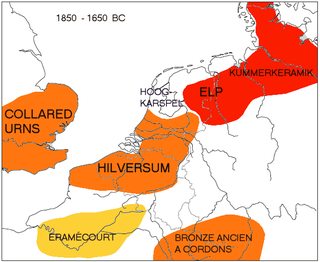
The Elp culture is a Bronze Age archaeological culture of the Netherlands having earthenware pottery of low quality known as "Kümmerkeramik" as a marker. The initial phase is characterized by tumuli, strongly tied to contemporary tumuli in Northern Germany and Scandinavia, and apparently related to the Tumulus culture in Central Europe. This phase was followed by a subsequent change featuring Urnfield (cremation) burial customs.
In Europe, the Iron Age is the last stage of the prehistoric period and the first of the protohistoric periods, which initially meant descriptions of a particular area by Greek and Roman writers. For much of Europe, the period came to an abrupt end after conquest by the Romans, though ironworking remained the dominant technology until recent times. Elsewhere, the period lasted until the early centuries AD, and either Christianization or a new conquest in the Migration Period.

Human habitation of present-day Sweden began around 12000 BC. The earliest known people belonged to the Bromme culture of the Late Palaeolithic, spreading from the south at the close of the Last Glacial Period. Neolithic farming culture became established in the southern regions around 4000 BC, but much later further north. About 1700 BC the Nordic Bronze Age began in the southern regions, based on imported metals; this was succeeded about 500 BC by the Iron Age, for which local ore deposits were exploited. Cemeteries are known mainly from 200 BC onward.

Poland in antiquity was characterized by peoples from various archeological cultures living in and migrating through various parts of what is now Poland, from about 400 BC to 450–500 AD. These people are identified as Slavs, Celts, Germanic peoples, Balts, Thracians, Avars, and Scythians. Other groups, difficult to identify, were most likely also present, as the ethnic composition of archeological cultures is often poorly recognized. While lacking any written language to speak of, many of them developed a relatively advanced material culture and social organization, as evidenced by the archeological record; for example, richly furnished, "princely" dynastic graves.

North Germanic peoples, commonly called Scandinavians, Nordic peoples and in a medieval context Norsemen, were a Germanic linguistic group originating from the Scandinavian Peninsula. They are identified by their cultural similarities, common ancestry and common use of the Proto-Norse language from around 200 AD, a language that around 800 AD became the Old Norse language, which in turn later became the North Germanic languages of today.

The Veksø helmets are a pair of Bronze Age ceremonial horned helmets found near Veksø in Zealand, Denmark.

The prehistory of the Netherlands was heavily influenced by the region's constantly changing, low-lying geography. Inhabited by humans for at least 37,000 years, the landscape underwent significant transformations, from the last ice age's tundra climate to the emergence of various Paleolithic groups. The region witnessed the development of the Swifterbant culture, which was closely linked to rivers and open water, while the Mesolithic era saw the creation of the world's oldest recovered canoe, the Pesse canoe. The arrival of agriculture around 5000–4000 BC marked the beginning of the Linear Pottery culture, which gradually transformed prehistoric communities.

Early Germanic culture refers to the culture of the early Germanic peoples. Largely derived from a synthesis of Proto-Indo-European and indigenous Northern European elements, the Germanic culture started to exist in the Jastorf culture that developed out of the Nordic Bronze Age. It came under significant external influence during the Migration Period, particularly from ancient Rome.